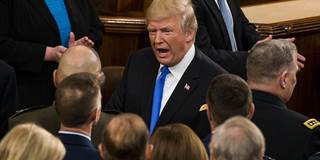After a year in office, US President Donald Trump's approach to policymaking has been nothing if not bizarre. Whereas past presidents have sought the middle ground in an effort to develop effective policies and win re-election, Trump seems dead set on antagonizing the majority of Americans who did not vote for him.
BERKELEY – America certainly has a different kind of president than what it is used to. What distinguishes Donald Trump from his predecessors is not just his temperament and generalized ignorance, but also his approach to policymaking.
First, consider Bill Clinton, who in 1992 was, like Trump, elected without a majority of voters. Once in office, Clinton appealed to the left with fiscal-stimulus and health-care bills (both unsuccessful), but also tacked center with a pro-growth deficit-reduction bill. He appealed to the center right by concluding the North American Free Trade Agreement (NAFTA), which had been conceived under his Republican predecessors; and by signing a major crime bill. And he reappointed the conservative stalwart Alan Greenspan to chair the US Federal Reserve.
Clinton hoped to achieve three things with this “triangulation” strategy: to enact policies that would effectively address the country’s problems; to convince voters who hadn’t supported him that he was looking out for their interests, too; and to keep his own base intact.

BERKELEY – America certainly has a different kind of president than what it is used to. What distinguishes Donald Trump from his predecessors is not just his temperament and generalized ignorance, but also his approach to policymaking.
First, consider Bill Clinton, who in 1992 was, like Trump, elected without a majority of voters. Once in office, Clinton appealed to the left with fiscal-stimulus and health-care bills (both unsuccessful), but also tacked center with a pro-growth deficit-reduction bill. He appealed to the center right by concluding the North American Free Trade Agreement (NAFTA), which had been conceived under his Republican predecessors; and by signing a major crime bill. And he reappointed the conservative stalwart Alan Greenspan to chair the US Federal Reserve.
Clinton hoped to achieve three things with this “triangulation” strategy: to enact policies that would effectively address the country’s problems; to convince voters who hadn’t supported him that he was looking out for their interests, too; and to keep his own base intact.